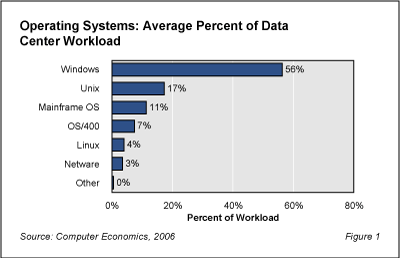Today, most data centers manage multiple operating systems (OS), which interoperate in a complex environment and require a high level of system management expertise. Consequently, IT decision-makers are continually challenged to decide which OS platforms are most suitable for their environments and what portion of the workload each should handle.
The mix of operating systems in the data center has been evolving rapidly over the past decade, as Linux and especially Windows have been replacing mainframe operating systems and Unix in many applications. But the economic characteristics of the newer operating systems are different than those of the platforms that they replace. Understanding the economic returns and risks of each operating system is an important part of the financial management of any data center, and this knowledge is greatly improved by understanding the economic experiences of other users.
This Research Byte is a summary of our full report, Data Center Operating System Trends and Economic Characteristics.
A recently completed Computer Economics survey of senior IT managers and CIOs provides insight into how the computing workload is allocated to various operating systems across companies of all sizes and in every industry sector. The results of this study, which includes data from nearly 200 companies, also provide insights into the experiences of these same organizations in terms of return on investment (ROI) and total cost of ownership (TCO) for three of these operating systems: Unix, Windows, and Linux.
Windows Leads the Pack
To determine the adoption rate for each operating system, we asked respondents what percentage of their data center processing workload is managed by each OS, regardless of the number of machines or instances of each OS in the data center. For example, if a data center has one mainframe and ten Windows servers, but the mainframe processes 99% of the workload, the survey respondent indicates 99% for the mainframe OS and 1% for Windows.
Figure 1 shows the average workload for each OS on a percentage basis across all survey respondents. Windows is the clear leader, averaging 56% of the workload across all data centers. Trailing far behind is Unix at 17% and mainframe operating systems at 11%. OS/400, Linux, and Netware together represent a small minority of the workload.

When assessing these results, keep in mind that responses are not weighted by data center size. For this reason, workload percentage is not equivalent to the installed base market share of each operating system. Furthermore, no attempt was made to segregate workload by processing type or whether mission criticality or high availability were required of the applications running under each OS.
Despite these limitations, Windows is without a doubt the big dog at corporate data centers. Almost every survey respondent reported using Windows in some capacity, which is a claim that no other operating system can make. In contrast, runner-up Unix is deployed in slightly more than two-thirds of data centers. Just over one-third of data centers in our study report using mainframe operating systems.
The full version of this report provides data on average OS workload by organization size and industry sector, and analyzes the economic characteristics of three of them: Windows, Unix, and Linux. It also makes a number of important recommendations and predictions regarding data center OS adoption trends and strategies for optimizing the ROI and TCO of these three operating systems.
Operating systems are an important battleground for the major technology vendors, as the choice of OS drives many other choices for IT procurement. Therefore, the relative advantages of each operating system are constantly shifting as vendors fight to increase their share of the data center workload, to the benefit of end-user organizations.
Managing OS Economics
As low-cost OS alternatives such as Windows and Linux demonstrate their ability to run enterprise-class applications, they raise the cost-performance bar for all other operating systems. This competition is good news for buyers. IT decision-makers should stay abreast of these latest developments and periodically evaluate their mix of operating systems and their economic characteristics. Most data centers, especially in large organizations, will continue to run multiple operating systems, which increases support costs. Ultimately, therefore, the CIO should decide which OS will be the preferred choice for delivering new systems and capabilities. Depending on the application, an OS migration can be a complex undertaking. However, if done in an incremental fashion, according to a well-thought-out OS strategy, the organization will be better able to manage data center costs and performance for the long run.
November 2006
This Research Byte is a brief overview of our report on this subject, Data Center Operating System Trends and Economic Characteristics. The full report is available at no charge for Computer Economics clients, or it may be purchased by non-clients directly from our website at https://avasant.com/report/data-center-os-trends-and-economic-characteristics-2006/ (click for pricing).

